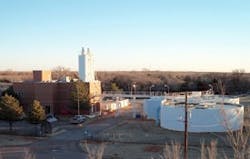It was a classic case of understatement.
The headline in an October 2010 edition of the Clinton (Okla.) Daily News proclaimed, "City sewer, water plants doing well."
During the summer of 2010, a public-private partner had begun operation of the city of Clinton's 4-million-gal-per-day (mgd) sewer plant and its 5.5-mgd Clinton Lake water treatment plant. The wastewater treatment plant was experiencing chronic sludge overloading when receiving only a quarter of the design flow. At the water treatment plant, turbidity rates were high, resulting in poor drinking water taste and odor. Energy consumption by the two plants was much higher than expected.
The first-year cost of the contract with the new public-private partner was approximately $160,000 less than it was costing the city to operate and maintain the plants by itself. Three months after the partnership commenced, water and wastewater quality and compliance had improved. The city manager reported that the plants were running at "much improved levels of efficiency," and the plants’ energy usage had been significantly reduced.
Doing well, indeed.
When Clinton officials decided to initiate a search for a public-private partner to operate its water and wastewater systems, they looked close to home, in Chickasha, Okla. Located 45 miles southeast of Oklahoma City, the Chickasha wastewater treatment plant has been operated by De Nora Water Technologies through a public-private partnership since 1979. After talking with Chickasha representatives, the city of Clinton chose De Nora Water Technologies to operate its plants.
Addressing Excessive Sludge Inventory
Prior to the partnership, compliance with Oklahoma Department of Environmental Quality (ODEQ) wastewater quality standards also was an issue, as the plant did not pass two consecutive quarterly whole effluent toxicity (WET) tests, requiring that the plant perform toxicity reduction evaluations.
"The wastewater plant is an activated sludge extended aeration plant. The plant was overloaded and was barely able to handle the incoming flow. The plant staff was not using any process controls for sludge wasting. Instead, they were estimating when wasting needed to be done—and land application of the plant's waste wasn't being done,” said Rusty Whisenhunt, project manager for De Nora Water Technologies. “This resulted in sludge levels in the clarifier that were at least five times what was optimal. The mixed liquor suspended solids (MLSS) count was about 10,000 mg/L, compared to a normal count of 2,500 mg/L. And the plant was processing only about 1 mgd of wastewater."
Within three months of taking over operation of the plant, De Nora Water Technologies staff instituted proper controls and increased the plant's operating capacity back to the plant's design capacity. The filamentous bacteria ( Nocardia amarae ) that had formed on the surface of the wastewater basins were no longer present, and the MLSS count was being maintained at 2,500 mg/L. As a result, two of the plant's three clarifiers were no longer needed and were taken offline.
Improving Drinking Water Quality
The quality of the city's drinking water, processed by the Clinton Lake treatment facility, also needed to be addressed. Turbidity rates were typically .2 to .25 NTU. Plant personnel determined that the automatic chlorine dioxide pre-oxidant system was not operating properly, enabling algae growth. Once the problem was identified, plant personnel restarted the system and adjusted the dosage rate. Working with various vendors, they were able to determine a better alum and cationic polymer blend. Once the proper blend was implemented, turbidity from the effluent filters was reduced to .05 NTU.
To solve the problem of long detention times in the water treatment system, as well as low total chlorine residuals that the system had experienced, De Nora Water Technologies personnel have identified a location for automatic flushing equipment, a SCADA system and supplemental chloramine injection locations. These actions will help the city remain in compliance with ODEQ regulations and with the U.S Environmental Protection Agency's Stage 2 Disinfection Byproducts Rule.
Significant Energy Savings
The wastewater plant and the Clinton Lake water treatment plant, combined, are the city of Clinton's largest user of electricity, so any reductions in energy usage at the plants was welcomed. Once De Nora Water Technologies had implemented efficiencies throughout the two plants—including, importantly, shutting down the two small clarifiers—energy use was reduced by 45% to 50%.
According to City Manager Grayson Bottom, regulatory compliance was the number one priority in bringing in a public-private partner. After nearly three months of working with De Nora Water Technologies, Bottom said an ODEQ representative visited the plants and was "absolutely radiant."
"The government official told Clinton representatives that the plants "had exceeded every expectation they had," Bottom said.
